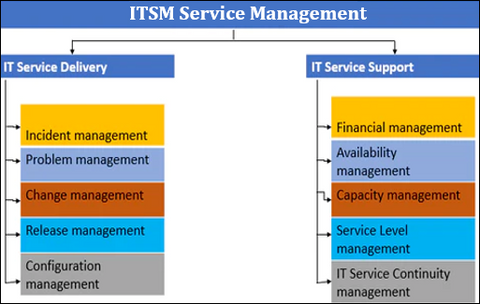ITSM Service Delivery | Difference Between IT Service Delivery & IT Service Support
Service Delivery
In ITSM, Service Delivery refers to the set of processes and activities aimed at designing, implementing, and managing IT services to meet the needs of the organization and its customers. It encompasses the strategic planning, design, transition, operation, and continual improvement of IT services to ensure they are aligned with business objectives and delivered effectively and efficiently. Service delivery begins with understanding the business requirements and translating them into tangible IT services that provide value to customers. This involves establishing service level agreements (SLAs), defining service portfolios, and designing service catalogs to document available services.

Be it any IT organization; no management would create budgets every day.
Be it any IT organization; no team would define availability plans for an IT service every day.
Be it any IT organization; no team would define capacity plans for an IT service every day.
Be it any IT organization; no teams would define continuity plans for an IT service every day.
Be it any IT organization; no teams would define SLAs for an IT service every day.
You do the above-mentioned activities once in a month or quarter or half a year; hence these activities are focused on the long term. Thus the processes Financial Management, Availability Management, Capacity Management, Service Level Management, and IT Service Continuity Management are categorized under Service Delivery.
Service Support
Service support refers to the set of processes and activities aimed at providing operational support for IT services, addressing user issues, incidents, and service requests promptly and effectively. Service support is primarily concerned with maintaining the day-to-day functionality of IT services and minimizing disruptions to business operations.
Service Desk is the function of Service support. Incidents, problems, changes, releases, configurations, and interactions with the service desk happen regularly in day-to-day operations. Hence these processes and functions are categorized as in-service support.
About ITIL v3 Service Delivery
ITIL v3 (IT Infrastructure Library version 3), Service Delivery is a critical aspect of IT Service Management (ITSM) that focuses on the planning, design, and delivery of IT services to meet business requirements and objectives. It encompasses several key processes aimed at ensuring that IT services are strategically aligned with the organization's needs and delivered efficiently and effectively. Service Delivery includes stages such as Service Strategy and Service Design, which collectively form the foundation for delivering IT services that provide value to the business.
In Service Strategy, organizations develop a clear understanding of their business objectives and requirements and translate them into IT services that support those goals. This involves activities such as service portfolio management, financial management for IT services, demand management, and business relationship management. Service Design focuses on designing IT services and the supporting processes to meet the agreed-upon service levels and requirements. It includes processes such as service catalog management, service level management, capacity management, availability management, IT service continuity management, and supplier management.
Difference Between ITSM Service Support and ITSM Service Delivery
| IT Service Support | IT Service Delivery |
| IT Service support focuses on providing day-to-day support in the IT operational environment. | IT Service delivery focuses on planning and designing IT infrastructure services. |
|
Processes involved in service support are Incident management, problem management, change management, release management, and configuration management. |
Processes involved in service delivery are Financial Management, Availability Management, Capacity Management, Service Level Management, and IT Service Continuity Management.
|
|
Has one function – Service Desk. |
No functions defined. |





